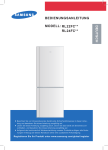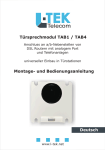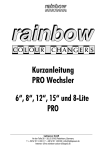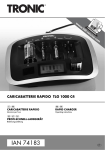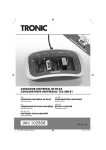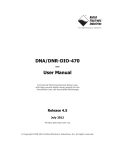Download Ansmann Energy XC 3000
Transcript
"LLV]#BUUFSZ.BOBHFNFOU4ZTUFN &/&3(: 9$ D GB ★★★★★ D TEST TEST -BEFO $IBSHF EST TEST TEST &OUMBEFO %JTDIBSHF TEST TEST 5FTUNPEVT]5FTUNPEF TEST TEST TEST 'FSUJH 3FBEZ TEST TEST ,BQB[JU¼U]$BQBDJUZ % TEST 'FIMFS &SSPS TEST 4QBOOVOH]7PMUBHF E TEST TEST 1SPHSBNN 1SPHSBN -BEFO $IBSHF TEST &OUMBEFO %JTDIBSHF TEST TEST 'FSUJH 3FBEZ 'FIMFS &SSPS $)"3(& %*4$)"3(& #"55&3:5&45 TEST TEST TEST TEST TEST TEST TEST TEST TEST TEST $:$-& F 5FTUNPEVT]5FTUNPEF TEST TEST &OUMBEFO %JTDIBSHF TEST ,BQB[JU¼U]$BQBDJUZ % TEST 'FSUJH 3FBEZ 4QBOOVOH]7PMUBHF TEST 'FIMFS &SSPS Energy xc 3000 A &/&3(: 9$ 1 5 2 5&45 7 -J*PO 5&45 6 3 5&45 %*4$)"3(& 7 4 5&45 #"55&3: 5&45 70-5"(& $633&/5 $"1"$*5: 5*.& 108&3 $:$-& N7 N" N"I NJOI 8T 8 1 5&45 7 5 2 5&45 -J*PO 7 5&45 -J*PO 5&45 6 3 5&45 %*4$)"3(& 7 #"55&3:5&45 70-5"(& $633&/5 $"1"$*5: 5*.& 108&3 8 4 5&45 5&45 7 $:$-& N7 N" N"I NJOI 8T -J*PO 5&45 -JUIJVN7$3$31 "MLBMJOF7-3-3 -3-3-3-3 0, 7 $3 7 -3 7 $31 7 -3 "MLBMJOF7-3 -3-3-3-3 7"MLBMJOF """""$% 7 7 7 " "MLBMJOF7"""""$% "MLBMJOF7" 7 $37 7 7/J$E/J.) """""$% $3 $3 1VTI -JUIJVN7$37 -JUIJVN7$3$3 ;JOD"JS7777 /J$E/J.)7"""""$% 7 7 $3 $3 7&#MPDL -JUIJVN7$3 $3$3$3 $3$3 -JUIJVN7$3 $3$3 $3$3 Energy xc 3000 B C 1 2 Energy xc 3000 D BEDIENUNGSANLEITUNG VORWORT Sehr geehrte Kundin, sehr geehrter Kunde, herzlichen Dank, dass Sie sich für das Ladegerät Energy XC3000 von ANSMANN entschieden haben. Die vorliegende Bedienungsanleitung wird Ihnen helfen, die Funktionen Ihres Energy XC3000 optimal zu nutzen. Bitte lesen Sie diese Bedienungsanleitung bevor Sie das Ladegerät in Betrieb nehmen. Wir wünschen Ihnen viel Freude mit Ihrem neuen Energy XC3000 Ladegerät. Ihr ANSMANN Team LIEFERUMFANG > Ladegerät Energy XC3000 > Netzgerät > Netzleitung > Universal-Adapterplatte zur Kontaktierung von Li-Ion/Li-Po Akkus > Bedienungsanleitung SICHERHEITSHINWEISE > Vor Inbetriebnahme Bedienungsanleitung sorgfältig lesen und Sicherheitshinweise beachten! > Bei Beschädigung des Gehäuses, des Netzsteckers oder des Kabels das Gerät nicht in Betrieb nehmen, wenden Sie sich an den autorisierten Fachhandel! > Für die Ladung von Rundzellen und 9V Akkus dürfen nur Nickel-Cadmium (NiCd) bzw. Nickel-Metallhydrid (NiMH) Akkus verwendet werden, bei anderen Batterien besteht Explosionsgefahr! Beim Einlegen dieser Akkus Polarität (+/-) beachten! > Für die Ladung von Lithium-Ionen (Li-Ion) oder Lithium- Polymer (Li-Po) Akkupacks muss die mitgelieferte Universal-Adapterplatte verwendet werden! > Es dürfen nur schnellladefähige Marken-Akkus in dem Gerät geladen werden, welche für die jeweiligen Ladeströme des Ladegerätes ausgelegt sind. Minderwertige Akkus können zur Zerstörung der Akkus und des Gerätes führen, da diese Akkus nicht für Schnellladung geeignet sind. Bei Verwendung nicht geeigneter Akkus in diesem Gerät kann leider kein Garantieanspruch gewährt werden! > Gerät darf nur in geschlossenen, trockenen Räumen betrieben werden! > Um Brandgefahr bzw. die Gefahr eines elektrischen Schlages auszuschließen, ist das Gerät vor Feuchtigkeit und Regen zu schützen! > Reinigungs- und Wartungsarbeiten nur bei gezogenem Netzstecker durchführen! > Gerät nicht öffnen! > Von Kindern fernhalten! > Gerät nicht unbeaufsichtigt betreiben! > Nach Gebrauch das Gerät vom Netz trennen! > Nichtbeachtung der Sicherheitshinweise kann zu Schäden am Gerät, an den Akkus oder zu gefährlichen Verletzungen von Personen führen! > Wir empfehlen die Verwendung von ANSMANN-Akkus! FUNKTIONSÜBERSICHT LADEGERÄT > Tisch-Ladestation für 1-8 Micro AAA oder Mignon AA; für 1-4 Baby C oder Mono D sowie für 1-2 St. 9V E-Block oder 1 Li-Ion/LiPo Akkupack (3,6/3,7V-7,2/7,4V) über die mitgelieferte UniversalAdapterplatte > Für NiCd, NiMH, Li-Ion/Li-Po Akkus geeignet > Multifunktionale, übersichtliche LCD Anzeige > Einstellbarer Ladestrom (2-stufig) für Rundzellen vor dem Kontaktieren der Akkus > Automatische Ladestromanpassung > Der Ladezustand vor Ladebeginn ist ohne Bedeutung > Kapazitäts-Schnelltest des eingelegten Akkus > Individuell auswählbare Ladeprogramme pro Ladeschacht • CHARGE (Laden) • DISCHARGE (Entladen) • BATTERY-TEST (Laden, Entladen, Laden) • CYCLE (1-10 Zyklen Entladen, Laden einstellbar) > Automatischer Ladebeginn innerhalb von 10 Sekunden nach Kontaktierung der Akkus falls keine Programmauswahl erfolgt > Einfache Erkennung der jeweils ausgewählten Ladeprogramme über LCD-Anzeige > Mikrocontrollergesteuerte Aufladung und Überwachung des Ladezustandes jedes einzelnen Akkus > Individuelle Abfrage aktueller Parameter während des Ladevorgangs • VOLTAGE (Lade-/Entladespannung) • CURRENT (Lade-/Entladestrom) • CAPACITY (Lade-/Entladekapazität) • TIME (Lade-/Entladezeit) > Mehrfacher Überladeschutz pro Akku > Impulserhaltungsladung für NiCd/NiMH Akkus > Akku-Defekt- und Alkaline-Erkennung > Verpolschutz > Weltweit einsetzbar dank Weitbereichsnetzteil (100-240V AC / 50-60Hz) FUNKTIONSÜBERSICHT AKKU/BATTERIE-TESTER > Zuverlässiges Testgerät für alle gängigen Akku/Batterie-Typen > Sekundenschnelles Messergebnis > Anzeige der Batterie-Spannung und der Kapazität (in 10%-Schritten) über LCD-Display Folgende Zellen können getestet werden: > 1,5V Alkaline Rundzellen & 1,2V NiCd/NiMH Akkus: Micro AAA, Mignon AA, Baby C, Mono D > 9V E-Block / 12V A23 > 1,5V Alkaline Knopfzellen: LR43, LR44, LR45, LR48, LR54, LR55, LR57, LR58, LR59, LR60, LR66 > 1,44V Zink-Luft Knopfzellen: V13, V675, V312 > 3V Lithium Knopfzellen: CR1025, CR1216, CR1220, CR1616, CR1620, CR2016, CR2025, CR2032, CR2320, CR2430, CR2450 > Lithium Photobatterien: 3V: CR2, CR123A, CR-V3 / 6V: CR-P2, 2CR5 INBETRIEBNAHME LADEGERÄT (siehe Abbildung A ) Das Gerät auf einen ebenen Untergrund stellen und darauf achten, dass die Lüftungsschlitze frei sind. Das Netzgerät mit dem Ladegerät verbinden und an die Stromversorgung anschließen (100-240V AC 50-60Hz). Die Displays sowie das ANSMANN Logo leuchten. Ladestrom einstellen Es kann nun, sofern kein Akku in das Ladegerät eingelegt ist, der Ladestrom für die Ladung von Rundzellen geändert werden. Hierzu die Bedientaste (5) „OK“ 1x drücken. Im Display (3) wird nun der aktuell eingestellte Ladestrom (Auslieferungszustand: 2000mA) für die Ladung von Mono D, Baby C und Mignon AA Akkus angezeigt. Dieser kann durch Drücken der Bedientaste (6) ◂ auf 1000mA reduziert werden. Durch Drücken der Bedientaste (7) ▸ wird er wieder auf 2000mA erhöht. Der gewählte Wert muss durch Drücken der Bedientaste (5) „OK“ bestätigt werden, danach erlischt die Anzeige im Display. Der ausgewählte Ladestrom wird nun für alle künftigen Ladungen verwendet sofern er nicht wieder geändert wird! Der Ladestrom für Micro AAA Akkus beträgt immer 25% des eingestellten Ladestroms. Für Li-Ion/Li-Po Akkus und 9V E-Blocks ist der Ladestrom nicht veränderbar. Kontaktierung Rundzellen Zum Einlegen von Rundzellen die silbernen Kontaktbügel (2) nach hinten ziehen und die Akkus auf den Grund des Ladeschachtes einlegen. Bitte beachten Sie, dass die Akkus polrichtig eingelegt werden (siehe Akkusymbole im Ladeschacht). Das Gerät ist mit vier Dual-Schächten für Rundzellen ausgestattet. In jeden Ladeschacht lassen sich entweder je 2 St. Micro AAA- / 2 St. Mignon AA- oder aber je 1 St. Baby C- oder Mono D- Akkus einlegen. Beim Einlegen eines Baby C- oder Mono D-Akkus beachten Sie bitte, dass beide Kontaktbügel am Akku anliegen und die Akkus sich mittig im Ladeschacht befinden. Kontaktierung 9V E-Block, UniversalAdapterplatte und Li-Ion/Li-Po Akkupacks Das Ladegerät kann zusätzlich zu den Rundzellen auch 1-2 Stück 9V E-Blocks oder 1 Li-Ion/Li-Po Akkupack (3,6/3,7V-7,2/7,4V) laden. Die Ladeschächte für die 9V E-Blocks (9) befinden sich unterhalb des LCD Displays (3). Hier können die zu ladenden 9V E-Blocks einfach polrichtig kontaktiert werden. Li-Ion/Li-Po Akkupacks können nur über die mitgelieferte Universal-Adapterplatte geladen werden. Die UniversalAdapterplatte wie in Abbildung C kontaktieren und im Ladegerät fixieren. Hierbei ist zu beachten, dass die Universal-Adapterplatte zuerst in die zwei Halterungsnasen (8) am oberen Ende geschoben und dann in Richtung Ladestation gedrückt wird bis sie einrastet. Danach den korrekten Halt der Universal-Adapterplatte überprüfen. Nun kann der zu ladende Li-Ion/Li-Po Akkupack wie folgt kontaktiert werden (siehe Abbildung B ): 1. REAR SLIDER (11) mittels SIZE ADJUSTOR (12) entsprechend der zu ladenden Akkugröße einstellen. Dazu den Abstand zwischen den Akkuladekontakten CONTACTS (14) und dem REAR SLIDER (11) etwas geringer wählen als die Akkugröße, damit der Akku beim Laden fest positioniert ist. 2. REAR SLIDER (11) nach hinten schieben, Akkupack mit der Kontaktseite in Richtung Akkuladekontakte CONTACTS (14) an GUIDE WALL (13) anlegen und mit REAR SLIDER (11) klemmen. 3. Akkupack etwas nach hinten in Richtung REAR SLIDER (11) schieben und Akkuladekontakte CONTACTS (14) mittels CONTACT ADJUSTER (15) auf Akkukontakte „+“ und „-“ einstellen. Akkupack wieder in Richtung Akkuladekontakte CONTACTS (14) schieben und loslassen. Bei korrekter Einstellung und Kontaktierung wird der Akku erkannt. Das Ladegerät erkennt die Polarität des Akkus automatisch. Um 9V E-Blocks zu laden muss die Universal-Adapterplatte entfernt werden. Hierzu die Taste (10) „Push“ drücken und die Universal-Adapterplatte entnehmen. Kapazitätsschnelltest und Auswahl der Ladeprogramme Nach dem Einlegen eines jeden Akkus blinkt in der LCD Anzeige das entsprechende Akkusymbol und es wird die Nummer „1…8“ bzw. der Akkutyp „9V“ oder „Li-Ion“ oberhalb des Akkusymbols angezeigt. Zusätzlich erscheint im Display „TEST“ unterhalb des Akkusymbols und es wird die Spannung des Akkus im Display (3) angezeigt. Über die 4 Balken innerhalb des Akkusymbols wird Energy xc 3000 der Ladezustand des Akkus angezeigt (siehe Abbildung F ). 0 Balken = Akku entladen 1 Balken = Kapazität unter 25% der Nennkapazität 2 Balken = Kapazität zwischen 26 und 50% der Nennkapazität 3 Balken = Kapazität zwischen 51 und 75% der Nennkapazität 4 Balken = Kapazität über 75% der Nennkapazität Während dieser Anzeige blinkt das Ladeprogramm CHARGE (Voreinstellung). Durch Drücken der Bedientasten (6) ◂ oder (7) ▸ kann nun zu den anderen Ladeprogrammen DISCHARGE, BATTERY-TEST oder CYCLE gewechselt werden. Die Programmauswahl wird für 10 Sekunden blinkend angezeigt und danach wird das ausgewählte Programm automatisch gestartet wenn nicht zuvor die Bedientaste (5) „OK“ gedrückt wird. Jeder weitere Tastendruck auf die Bedientasten (6) ◂ oder (7) ▸ innerhalb der 10 Sekunden oder jedes Einlegen von Zellen startet die 10 Sekunden erneut. Wenn mehrere Zellen in dieser Zeit eingelegt werden, wird das gleiche Ladeprogramm für diese Zellen gestartet. Beschreibung der Ladeprogramme: (siehe Abbildung E ) CHARGE Akku wird geladen (Batteriesymbol wird von unten nach oben aufgefüllt); wenn der Akku geladen ist wird im Display (3) die eingeladene Kapazität angezeigt DISCHARGE Akku wird entladen (Batteriesymbol wird von oben nach unten entleert); wenn der Akku entladen ist wird im Display (3) die entladene Kapazität angezeigt BATTERY-TEST Akku wird geladen, entladen und wieder geladen; wenn der Akku geladen ist wird im Display (3) die entladene Kapazität angezeigt CYCLE Akku wird mit der eingestellten Zyklenzahl (1-10) geladen und entladen; die voreingestellte Zyklenzahl ist 3, kann aber durch Drücken der Bedientaste (6) ◂ verringert bzw. durch Drücken der Bedientaste (7) ▸ erhöht werden. Nach dem letzten Zyklus wird der Akku geladen; wenn der Akku geladen ist wird im Display (3) die zuletzt entladene Kapazität angezeigt Beschreibung der LCD Anzeige: Die Nummer „1…8“ bzw. der Akkutyp „9V“ oder „Li-Ion“ oberhalb des Akkusymbols signalisiert, welcher Akku momentan ausgewählt ist. Der im Display (3) angezeigte Wert bezieht sich immer auf den momentan ausgewählten Akku. Durch Drücken der Bedientaste (6) kann der vorherige Akku bzw. durch Drücken der Bedientaste (7) ▸ kann der nächste Akku ausgewählt werden. Wenn man den jeweiligen Akku erreicht hat, selektiert man diesen mit der Bedientaste (5) „OK“. Das Symbol des ausgewählten Akkus und der momentan angezeigte Wert im Display (3) blinken nun. Durch Drücken der Bedientasten (6) ◂ oder (7) ▸ kann nun ein anderer Parameter angezeigt werden. Folgende Parameter können ausgewählt werden: VOLTAGE Anzeige der aktuellen Zellenspannung in V CURRENT Anzeige des aktuellen Lade-/Entladestromes in mA CAPACITY Anzeige der aktuell eingeladenen/ entladenen Kapazität in mAh TIME Abgelaufene Zeit des aktuellen Vorgangs Während ein Ladeprogramm läuft wird immer die Spannung des selektierten Akkus angezeigt. Sobald das Ladeprogramm für eine Zelle endet, wird automatisch in die Detailansicht dieser Zelle geschaltet und deren Kapazität im Display (3) angezeigt. Anschließend kann jederzeit über die Bedientasten (6) ◂ oder (7) ▸ wieder eine andere Zelle ausgewählt werden. Zusatzinfos Die Kühlung des Ladegerätes erfolgt durch eingebaute Lüfter. Die Lüfter laufen, sobald mindestens eine Rundzelle geladen oder entladen wird. Eine Erwärmung der Akkus während des Ladevorganges ist normal. Nach der Aufladung von Rundzellen und 9V E-Blocks erfolgt automatisch eine Umschaltung auf Impuls-Erhaltungsladung. INBETRIEBNAHME AKKU/BATTERIE-TESTER Der Akku/Batterie-Tester ist funktionsfähig, sobald das Ladegerät an der Stromversorgung angeschlossen ist. Es ist möglich Akkus im Ladegerät zu laden und gleichzeitig Batterien oder Akkus in der Teststation zu überprüfen. Durchführung von Messungen: In der Frontseite des Ladegerätes befindet sich die Messspitze (1), welche zum Prüfen von Rundzellen benötigt wird. 1. Wählen Sie den entsprechenden Prüfkontakt um die zu prüfende Zelle zu kontaktieren (siehe Abbildung A ). 2. Positionieren Sie die Zelle unter Beachtung der Polarität an dem entsprechenden Prüfkontakt (beide Pole müssen kontaktiert sein). Beim Prüfen von Rundzellen wird die Messspitze (1) immer am Minuspol der Zelle kontaktiert! 3. Nach der Kontaktierung beider Pole einer Zelle erscheint im Display (4) „CALC“ (ca. 2 Sekunden). Dann wird für ca. 2 Sekunden der Energiegehalt der Zelle in % (10% Schritte) angezeigt und danach für weitere 2 Sekunden die Zellenspannung in Volt. Solange die Zelle kontaktiert bleibt, wechselt die Anzeige im Display zwischen Energiegehalt und Zellenspannung (siehe Abbildung D ). Achten Sie darauf, dass die Prüfkontakte am Gerät sowie die Kontaktflächen der Zellen frei von Verschmutzungen sind. Es kann bei neuen Batterien vorkommen, dass nicht die volle Kapazität angezeigt wird. Dies liegt unter Umständen daran, dass die Batterie noch nicht „aktiviert“ ist. Bitte den Testvorgang in diesem Fall häufiger wiederholen. UMWELTHINWEISE Werfen Sie das Gerät keinesfalls in den normalen Hausmüll. Entsorgen Sie das Gerät über einen zugelassenen Entsorgungsbetrieb oder über Ihre kommunale Entsorgungseinrichtung. Beachten Sie die aktuell geltenden Vorschriften. Setzen Sie sich im Zweifelsfall mit Ihrer Entsorgungseinrichtung in Verbindung. Führen Sie alle Verpackungsmaterialien einer umweltgerechten Entsorgung zu. WARTUNG/PFLEGE Um eine einwandfreie Funktion des Gerätes sicherzustellen, halten Sie bitte die Kontakte von Ladegerät und Akkus frei von Verschmutzungen. Reinigung des Gerätes nur bei gezogenem Netzstecker und mit einem trockenen Tuch durchführen. Eine Reparatur darf nur durch eine Fachkraft erfolgen! TECHNISCHE DATEN Eingangsspannung: 100-240V AC / 50-60Hz (Netzteil) Ausgangsspannung: 8x 1.45V DC; 2x 10.15V DC; 1x 3.6-7.4V DC (Ladegerät) Ladestrom: Mono D: 4x 2000mA oder 1000mA Baby C: 4x 2000mA oder 1000mA Mignon AA: 8x 2000mA oder 1000mA Micro AAA: 8x 500mA oder 250mA 9V E-Block: 2x 75mA Li-Ion/Li-Po: 1x 700mA FEHLERDIAGNOSE Ladegerät zeigt keine Funktion: > Überprüfen Sie, ob das Netzkabel richtig in die Steckdose eingesteckt ist und das Netzteil mit dem Ladegerät verbunden ist > Überprüfen Sie, ob die Steckdose Strom führt; schließen Sie dazu ein anderes funktionstüchtiges Elektrogerät an die Steckdose an Akku wird nicht geladen: > Überprüfen Sie bei Rundzellen, ob die Akkus polrichtig eingelegt wurden; Rundzellen müssen gemäß dem Akkusymbol im Ladeschacht eingelegt sein > Überprüfen Sie bei Li-Ion/Li-Po Akkupacks, ob die Adapterplatte richtig kontaktiert wurde und ob die Kontakte der Adapterplatte auf die richtige Position zur Kontaktierung des Akkupacks eingestellt wurden > Überprüfen Sie, ob Sie zum Aufladen geeignete Akkus in das Ladegerät eingelegt haben; zum Aufladen eignen sich ausschließlich NiCd/NiMH Akkus der Typen AAA, AA, C, D und 9V E-Block sowie Li-Ion/Li-Po Akkupacks welche nur über die mitgelieferte Universal-Adapterplatte geladen werden können > Erscheint im Display das Fehlersymbol (siehe Abbildung E ), ist der Akku defekt oder es wurde eine Alkaline Batterie zum Laden eingelegt Andere Funktionsstörungen: > Wenden Sie sich bitte an unsere Service-Hotline HAFTUNGSAUSSCHLÜSSE Die in dieser Bedienungsanleitung enthaltenen Informationen können ohne Vorankündigung geändert werden. ANSMANN übernimmt keine Haftung für direkte, indirekte, zufällige oder sonstige Schäden oder Folgeschäden, die aus dem Gebrauch oder durch die Verwendung der in dieser Bedienungsanleitung enthaltenen Informationen entstehen. GARANTIEHINWEISE Auf das Gerät bieten wir eine dreijährige Garantie. Bei Schäden am Gerät, welche von minderwertigen Akkus verursacht werden, kann keine Garantie gewährt werden. Sollten irgendwelche Fragen in der Handhabung auftauchen oder eine Einsendung des Gerätes notwendig sein, bitten wir Sie, sich zuerst an unsere Service-Hotline unter Tel. 06294 4204 34 zu wenden. Wir helfen Ihnen schnell und unkompliziert weiter. Im Falle einer Reklamation legen Sie bitte neben dem Garantienachweis (Kaufbeleg) eine kurze Fehlerbeschreibung sowie Ihre genaue Anschrift, möglichst mit Telefonnummer bei und senden das Gerät an uns zurück (Adresse siehe Rückseite der Bedienungsanleitung). Technische Änderungen vorbehalten. Für Druckfehler übernehmen wir keine Haftung. 08/2008 Energy xc 3000 GB OPERATING INSTRUCTIONS FOREWORD FUNCTIONAL OVERVIEW OF CHARGER Dear Customer, > Desktop charger for 1-8 AAA or AA cells; for 1-4 C or D cells in addition to 1-2pcs 9V E-Block or 1 Li-Ion/Li-Po battery pack (3.6/3.7V-7.2/7.4V) connected by the universal adapter plate provided. > Suitable for NiCd, NiMH, Li-Ion/Li-Po batteries > Multifunctional clear LCD display > Adjustable charging current (2 steps) for all round cells > Automatic charging current adjustment > Charge condition is irrelevant before charging > Capacity quick test of the inserted cells > Individually selectable charging programs per charging slot • CHARGE • DISCHARGE • BATTERY-TEST (charging, discharging, charging) • CYCLE (1-10 cycles discharging/charging adjustable) > Automatic start of charging within 10 seconds after contact with the battery if no charging program is selected. > The selected charging program is displayed on the LCD display > Microprocessor controlled charging and supervision of each cell > Individual monitoring of critical parameters during charging • VOLTAGE (charge/discharge voltage) • CURRENT (charge/discharge current) • CAPACITY (charge/discharge capacity) • TIME (charge/discharge time) > Multiple over charging protection > Trickle charging for NiCd/NiMH batteries > Faulty cell detection and Alkaline detection > Wrong polarity protection > Switch mode power supply for world wide use (100-240V AC / 50-60Hz) Thank you for deciding to buy the ANSMANN Energy XC3000 charger. These operating instructions will help you to use all features of your Energy XC3000 charger in an optimum way. Please read the operating instructions carefully before use. We hope you are happy with your new charger. Your ANSMANN Team INCLUDED IN SET > Charger Energy XC3000 > Power supply > Mains lead > Universal adapter plate for connecting Li-Ion/Li-Po batteries > Operating instructions SAFETY INSTRUCTIONS > Please read the operating instructions carefully before using the charger! > Do not use the device if there are signs of any damage to the housing, mains plug or cable. Please contact an authorised dealer! > For charging of round cells and 9V batteries use only with NiCd/NiMH cells. Other types could cause an explosion! Observe polarity (+/-) prior to use! > For charging of Li-Ion/Li-Po batteries the universal adapter plate provided must be used! > Please note that due to the high charging current, use only good quality batteries from a well known brand in this charger. Using inferior quality batteries could cause damage to the batteries themselves, and/or the charger, if they are not suitable for fast charging. If unsuitable cells are inserted in the charger, warranty claims cannot be accepted and the warranty will become void! > Keep the charger in a dry place! > In order to avoid the risk of fire and/or electric shock, the charger must be protected against high humidity and water! > Before cleaning the unit, disconnect it from the mains and only use a dry cloth! > Never attempt to open the charger! > Keep away from children's reach! > Do not leave the device unattended when in operation! > Disconnect device from mains supply after use! > If the safety instructions are not followed, it may lead to damage to the device or battery and could cause injury! > We recommend the use of ANSMANN rechargeable batteries! FUNCTIONAL OVERVIEW BATTERY TESTER > Reliable tester for all common batteries > Ultra fast testing result > Indication of the battery voltage and capacity (in 10% steps) by the LCD display The following cells can be tested: > 1.5V Alkaline cylindrical cells & 1.2V NiCd/NiMH batteries: AAA, AA, C, and D cells > 9V E-block / 12V A23 > 1.5V Alkaline button cells: LR43, LR44, LR45, LR48, LR54, LR55, LR57, LR58, LR59, LR60, LR66 > 1,44V Zinc-Air button cells: V13, V675, V312 > 3V Lithium button cells: CR1025, CR1216, CR1220, CR1616, CR1620, CR2016, CR2025, CR2032, CR2320, CR2430, CR2450 > Lithium photo batteries: 3V: CR2, CR123A, CR-V3 / 6V: CR-P2, 2CR5 CHARGER OPERATION (see picture A ) Place the charger on a level surface and make sure that the ventilation slots are not covered. Connect the power adaptor to the charger, then connect the power supply to mains (100-240V AC 50-60Hz). The LCD displays and ANSMANN logo glows. Charging current setting Before inserting any battery into the charger, it is possible to change the charging current for round cell charging by pushing the button "OK" (5) one time. In the LCD display (3) you will now see the adjusted charging current (delivery status: 2000mA) for charging Mono D, Baby C and Mignon AA batteries. By pushing the button ◂ (6), the charging current can be decreased to 1000mA. By pushing the button ▸ (7), the charging current can be increased to 2000mA. The selected value has to be confirmed by pushing the button "OK" (5) and then the indication in the display is blank. Now the selected current will be used for all future charges, unless changed again! The charging current for Micro AAA batteries is always 25% of the adjusted charging current. For Li-Ion/Li-Po and 9V E-blocks the charging current is not adjustable. Contact - round cells To insert round cells, move the silver contact bridge (2) backwards and put in the rechargeable battery at the bottom of the charging slot. Always connect the cells in the right direction for polarity (according to the symbols in the charging slots). The charger is equipped with 4 dual slots for round cells. In each of these charging positions you can either insert 2pcs of Micro AAA or Mignon AA cells or 1pc of Baby C or Mono D cells. When inserting Baby C or Mono D cells both contact bridges must fit closely on the battery and the cells must be located centrally. Contact - 9V E-block, universal adapter plate and LiIon/Li-Po battery packs In addition to round cells, the charger can also charge 1-2pc 9V E-blocks or 1 Li-Ion/Li-Po battery pack (3.6/3.7V-7.2/7.4V). The charging slots for the 9V E-blocks (9) are located below the LCD display (3). Here the 9V E-blocks to be charged can be easily connected in the right polarity. Li-Ion/Li-Po battery packs can only be charged by using the provided universal adapter plate. Connect the universal adaptor plate to the charger as shown on picture C. Please move the universal adapter plate first into the two projections (8) at the upper end and push it in the direction of the charge station until locked in place. Afterwards please check the correct fixing of the universal adapter plate. Now the Li-Ion/Li-Po battery pack can be connected as follows (see picture B ): 1. By pushing SIZE ADJUSTOR (12) you can move the REAR SLIDER (11) to adjust it according to the size of the battery pack. The distance between CONTACTS (14) and REAR SLIDER (11) has to be shorter than the size of the battery pack so that the battery pack will be firmly positioned during charging. 2. Move the REAR SLIDER (11) backwards and insert the battery pack so that the side of the battery pack will touch the GUIDE WALL (13) and the contacts of the battery pack will be in direction of CONTACTS (14). The battery pack will be held now by the REAR SLIDER (11). 3. Move the battery pack in direction REAR SLIDER (11) and adjust the position of CONTACTS (14) by the CONTACT ADJUSTER (15) to the “+“ and “-“ contact of the battery pack. Push the battery pack back in direction CONTACTS (14) and release. If the adjustment and contacting is correct, the charger will identify the battery pack. The charger will detect the polarity of the battery pack automatically. To charge 9V E-blocks, the universal adapter plate has to be removed. Therefore press the button “Push” (10) and remove the universal adapter plate. Capacity quick test and charging programs After insertion of each battery, the appropriate battery icon in the LCD display flashes and its number “1…8” or battery type “9V” or “Li-Ion” is indicated above the battery icon. In addition “TEST” appears in the display below the battery icon and the voltage of the battery is indicated in display (3). The charge state of the battery will be indicated by the 4 bars inside the battery icon (see picture F ). 0 bar = battery discharged 1 bar = capacity below 25% of the nominal capacity 2 bars = capacity between 26 and 50% of the nominal capacity 3 bars = capacity between 51 and 75% of the nominal capacity 4 bars = capacity over 75% of the nominal capacity During this indication, the program CHARGE is flashing (preadjustment). By pushing the button ◂ (6) or ▸ (7), you can change to the other programs like DISCHARGE, BATTERY-TEST or CYCLE. The selection will flash for 10 seconds and then the selected program starts automatically if the button “OK” (5) is not pushed before. Each push of the button ◂ (6) or ▸ (7) within 10 seconds or each insert of any battery re-starts the 10 seconds again. If several batteries are inserted consecutively, the same charge program will be Energy xc 3000 used for these batteries. Additional information Description of charging programs: (see picture E ) The charger is cooled by built-in fans. The fans run when at least one round cell is charged or discharged. It is normal that batteries may become warm during charging. After charging of round cells and 9V E-Blocks is complete, the charger switches automatically to trickle charge. CHARGE Battery will be charged (battery icon is filled up from bottom to top); when the battery is fully charged, the charged capacity will be shown in the LCD display (3) BATTERY TESTER OPERATION DISCHARGE Battery will be discharged (battery icon is emptied from top to bottom); when the battery is discharged, the discharged capacity will be shown in the LCD display (3) Once the charger is connected to mains, the battery tester is ready for use. It is possible to charge rechargeable batteries in the charger and to test batteries or rechargeable batteries at the same time. BATTERY-TEST Battery will be charged, discharged and charged; when the battery is fully charged, the discharged capacity will be shown in the LCD display (3) How to make measurements: CYCLE Battery will be charged and discharged with the adjusted number of cycles (1-10); the pre-adjustment of cycles is 3 but by pushing the button ◂ (6), the number of cycles can be reduced and by pushing the button ▸ (7), the number of cycles can be increased. After the last cycle, the battery will be fully charged and the last discharged capacity will be shown in the LCD display (3) 1. Select the appropriate test terminal for the battery under test (see picture A ). Description of the LCD display: The number “1…8” or battery type “9V” or “Li-Ion” above the battery icon indicates which battery currently is selected. The display (3) indicated value always refers to the currently selected battery. By pushing the button ◂ (6), the previous battery or by pushing the button ▸ (7) the next battery can be selected. After choosing the respective battery, it can be selected by pushing the “OK” (5) button. Then the icon of the selected battery and the currently indicated value in the LCD display (3) will flash. By pushing the button ◂ (6) or ▸ (7) another parameter can be indicated. The following parameters can be selected: VOLTAGE Indication of the current battery voltage in V CURRENT Indication of the current charge-/discharge current in mA CAPACITY Indication of the current charged/discharged capacity in mAh TIME Elapsed time of the current process While a charge program is running, always the VOLTAGE of the selected battery is indicated. When the charge program for one battery ends, the indication switches automatically in the view of this battery and shows the CAPACITY in the LCD display (3). Another battery can be selected at any time by pushing the button ◂ (6) or ▸ (7). In the front of the charger is the test pin (1), which is only needed for testing of round cells. 2. Place the battery on the corresponding test terminal, paying attention to the polarity (both contacts must be connected). When checking round cells, the test pin (1) always has to be connected to the negative pole of the battery! 3. After both poles of a battery are contacted, in the display (4) appears "CALC" (for about 2 seconds). Then the capacity of the battery will be shown in 10% steps for approx. 2 seconds and for further 2 seconds the voltage of the battery will be shown. As long as the battery is contacted, the display changes between capacity and voltage (see picture D ). Make sure that the contacts of the test terminals and the contacts of the batteries are clean. With a new battery it is possible that the full capacity may not be shown. The battery needs to “wake up”. In this case please repeat the test again. ENVIRONMENTAL COMMENTS Do not dispose of the device in the normal household waste. Please return it to your dealer or to your nearest recycling centre or collection point. Please recycle all packing materials for the sake of the environment. CARE & MAINTENANCE To make sure that the charger works properly, please keep the contacts in the charging slots free from dust or contamination. To clean the unit, disconnect it from the mains and use only a dry cloth. Repair may only be undertaken by competent authorised dealers! TECHNICAL DATA WARRANTY NOTICE Input voltage: 100-240V AC 50-60Hz (power supply) We hereby offer a 3 year warranty on this charger. This does not apply to damage caused by low-quality batteries leaking inside the charger. Output voltage: 8x 1.45V DC; 2x 10.15V DC; 1x 3.6-7.4V DC (charger) Charging current: Mono D: 4x 2000mA or 1000mA Baby C: 4x 2000mA or 1000mA Mignon AA: 8x 2000mA or 1000mA Micro AAA: 8x 500mA or 250mA 9V E block: 2x 75mA Li-Ion/Li-Po: 1x 700mA FAULT DIAGNOSIS The charger has no function: > check if the mains lead of the power supply is correctly connected to the power outlet and if the output cable of the power supply is correctly connected to the charger > check if the outlet has power; connect another functional electrical device to check the power outlet The inserted battery is not being charged: > check if the batteries are inserted with the correct polarity; cylindrical batteries have to be inserted as per the battery symbol engraving in the charging slot > ensure that you inserted suitable rechargeable batteries into the charging slot; suitable batteries for charging are only NiCd/NiMH battery types of AAA, AA, C, D, and 9V block as well as Li-Ion/Li-Po battery packs which can only be charged by using the provided universal adapter plate > check for Li-Ion/Li-Po battery packs whether the universal adapter plate is connected in the right way and whether the contacts of the adapter plate are in the correct position to contact the battery pack > when the display shows the error symbol (see picture E ), the battery is defective or a non rechargeable battery was inserted Other problems > please contact us (address see last page of this operating instructions) DISCLAIMER Information in these operating instructions can be changed without prior notice. ANSMANN cannot accept liability for direct, indirect, accidental or other claims or consequential damages originated by using this charger and information given in these operating instructions. Technical details subject to change without prior notice. No liability accepted for typographical errors or omissions. 08/2008 V1 0805 ANSMANN AG Industriestr. 10 97959 Assamstadt Germany www.ANSMANN.de
This document in other languages
- Deutsch: ANSMANN 5207452
















